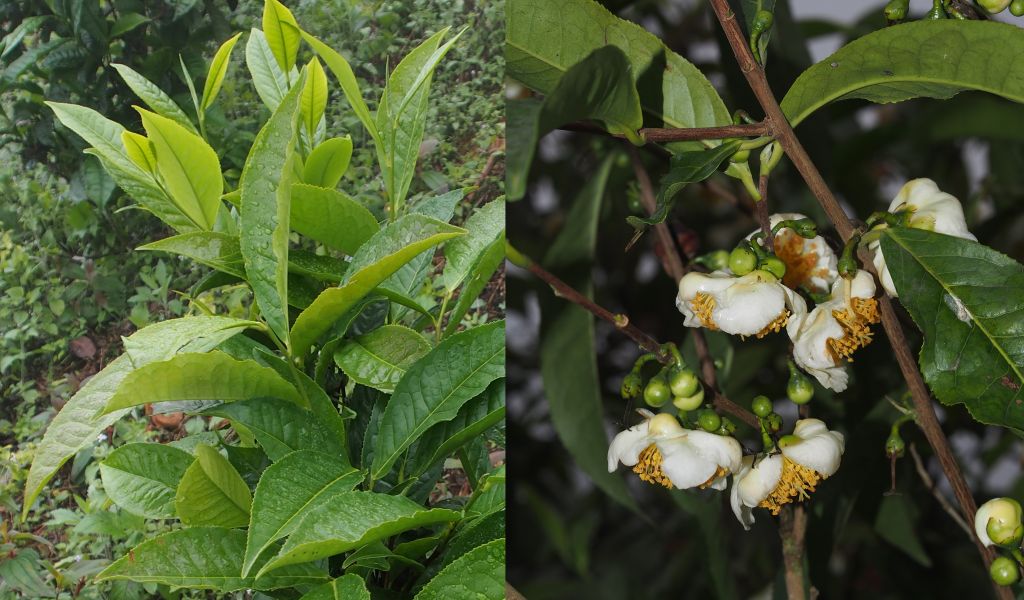ຊາປ່າ
Wild Tea
Camellia sinensis var. assamica (J.W.Mast.) Kitam.
ພືດ
ໄມ້ຢືນຕົ້ນ
ຕົ້ນໄມ້ ແລະ ປາມ
Camellia assamica var. kucha Hung T. Chang & H.S.Wang
Camellia dishiensis F.C.Zhang, X.Y.Chen & G.B.Chen
Camellia multisepala Hung T. Chang & Y.J. Tang
Camellia polyneura Hung T. Chang & Y.J. Tang
Camellia scottiana Choisy
Camellia theifera Griff.
Thea assamica J.W. Mast.
Thea chinensis var. assamica (J.W. Mast.) Pierre
Thea viridis var. assamica (J.W. Mast.) Choisy
ນິເວດວິທະຍາ
ການນຳໃຊ້
ຊາມີຄວາມສໍາຄັນຫລາຍດ້ານຕໍ່ຮ່າງກາຍ, ປະຊາຊົນໄດ້ຮັບຮູ້ຫຼາຍກວ່າຫລາຍພັນປີແລ້ວ. ຊາແມ່ນສ່ວນຫນຶ່ງຂອງວັດທະນະທໍາໃນບັນດາປະເທດຕ່າງໆທົ່ວໂລກເຊິ່ງເປັນສ່ວນປະກອບຂອງພິທີການ, ເສັ້ນທາງການຄ້າ ແລະ ເຖິງແມ່ນວ່າຈະເລີ່ມຕົ້ນຂອງການໝູນວຽນ. ຂ້າງລຸ່ມນີ້ແມ່ນຄຸນປະໂຫຍດຂອງຊາຕໍ່ສຸຂະພາບທີ່ພຽງແຕ່ດື່ມຊາກັບປະຈໍາວັນຂອງທ່ານ.
ການດູແລສຸຂະພາບໂດຍລວມ: ຊາມີສານຕ້ານອະນຸມູນອິສະລະ, ຊາມີຄາເຟອິນຫນ້ອຍກ່ວາກາເຟ ແລະ ຊາຊ່ວຍໃຫ້ທ່ານດູດຊຶມ.
ສຸຂະພາບຈິດ: ຊາສາມາດສ້າງຄວາມສະຫງົບ ແລະ ມີສະຕິລະມັດລະວັງຫຼາຍກວ່າເກົ່າ, ຊາຈະປັບປຸງຄວາມບົກຜ່ອງດ້ານຄວາມຮູ້ສຶກ, ຊາຫຼຸດລົງລະດັບຮໍໂມນຄວາມເຄັ່ງຕຶງ, ຊາຜ່ອນຄວາມອຸກອັ່ງ, ອາການເຈັບຫົວ, ຄວາມກົດດັນປະສາດ ແລະ ການນອນໄມ່ຫລັບ, ຊາສາມາດປັບປຸງຄວາມຊົງຈື່ສຳຫຼັບຜູ້ມີຄວາມຊົງຈຳສັ້ນ.
ຫົວໃຈ ແລະ ອະໄວຍະວະອື່ນໆ: ຊາສາມາດຫຼຸດຜ່ອນຄວາມສ່ຽງຕໍ່ການເປັນພະຍາດຫົວໃຈ ແລະ ເສັ້ນເລືອດຕັນ, ຊາປົກປ້ອງກະດູກຂອງທ່ານ, ຊາສາມາດປົກປ້ອງໂລກຫົວໃຈໄດ້. ຊາສາມາດຊ່ວຍລົດ ຄລໍເຣດສະໂຕຣອລໄດ້. ຊາສາມາດຊ່ວຍຫຼຸດຜ່ອນຄວາມດັນເລືອດ, ຊ່ວຍໃນການຍ່ອຍອາຫານ, ຊາຊ່ວຍປ້ອງກັນການອັກເສບຂອງລໍາໄສ້.
ຮ່າງກາຍ ແລະ ການອອກກໍາລັງກາຍ: ຊາຊ່ວຍປົກປ້ອງຮອຍຍີ້ມຂອງທ່ານ, ຊາບໍ່ມີແຄລໍລີ່, ຊາຈະເພີ່ມການເຜົາຜານອາຫານຂອງທ່ານ, ຊາຊ່ວຍໃນການບຳລູງຜິວຫນັງ, ຊາສາມາດຊ່ວຍລົດກີ່ນປາກ.
ອາການປ່ວຍ ແລະ ພະຍາດ: ຊາເສີມສ້າງພູມຕ້ານທານຂອງທ່ານ, ຊາປ້ອງກັນມະເຮັງ, ຊາສາມາດຊ່ວຍປ້ອງກັນຂໍ້ອັກເສບ, ຊາສາມາດຊ່ວຍຕ້ານໄຂ້ຫວັດໃຫຍ່, ຊາຊ່ວຍປ້ອງກັນການຕິດເຊື້ອ. ຊາສາມາດຫຼຸດຜ່ອນຄວາມສ່ຽງຕໍ່ການເປັນພະຍາດປາກກິນຊັນ, ຊາສາມາດປ້ອງກັນອາຫານທີ່ເປັນສານພິດ, ຊາສາມາດຊ່ວຍຢັບຢັ້ງການຕິດເຊື້ອ HIV, ຊາສາມາດຊ່ວຍປ້ອງກັນພະຍາດເບົາຫວານ, ຊາສາມາດຫຼຸດນ້ຳຕານໃນເລືອດ, ຊາສາມາດຮັກສາທາດເຫຼັກ, ຊາສາມາດຊ່ວຍຜ່ອນຄາຍອາການເປັນຫວັດ.
ການຄຸ້ມຄອງຈັດການ
ໂພຊະນາການ
| ສານອາຫານ | /100g | ໝາຍເຫດ |
|---|---|---|
| ໂປຣຕີນ | N/A | N/A |
| ຄາໂບໄຮເດຣດ | N/A | N/A |
| ໄຂມັນ | N/A | N/A |
| ວິຕາມິນ | N/A | N/A |
| ແຮ່ທາດ | N/A | N/A |
| ເສັ້ນໄຍ | N/A | N/A |
ອ້າງອິງ
Boupha, T. 2011. Tea Resource Inventory in Xiengkhouang and Luang Prabang Provinces. Vientiane, The Agro-Biodiversity Initiative Project: 13.
CARE. 2009. Lao Wild Forest Tea Sector Development: Stakeholder Workshop. Vientiane.
Chanthirath, K. 2011. Scope Tea Research. Vientiane, National Agriculture and Forestry Research Institute: 26.
Chen L, Yu FL, Tong QQ. 2000. Discussions on phylogenetic classification and evolution of sect. Thea. Tea Sci., 20(2): 89-94.
Fang, W.-P., L. W. Meinhardt, et al. 2014. "Varietal identification of tea (Camellia sinensis) using nanofluidic array of single nucleotide polymorphism (SNP) markers." Horticulture Research 1(14035): 8.
MAF. 2011. Lao Agricultural Census: 2010/11. Vientiane, Ministry of Agriculture and Forestry Lao PDR.
NAFRI 2007. Manual for tea cultivation (translated from Lao). Vientiane, Ministry of Agriculture and Forestry Lao PDR.
NAFRI, NAFES, et al. 2011. Northern Lao Wild Forest Tea Sub-Sector Feasibility and Design Study: Land Suitability Evaluation for Tea Growing in the North. Vientiane: 12.
NAFRI, NAFES, et al. 2011. Northern Lao Wild Forest Tea Sub-Sector Feasibility and Design Study: Project Summary
NAFRI, NAFES, et al. 2011. Northern Lao Wild Forest Tea Sub-Sector: Feasibility and Design Study.Vientiane, Ministry of Agriculture and Forestry Lao PDR.
NAFRI, NAFES, et al. 2011. Policy Brief Tea’s of Northern Laos: First Policy. Vientiane: 4.
NAFRI, NAFES, et al. 2011. Policy Brief Tea’s of Northern Laos: Second Policy-The Yunnan Market for Lao Teas. Vientiane: 5.
NAFRI, NAFES, et al. 2011. Tea Sector: Challenges and Opportunities. Vientiane.
Phouyyavong, K., T. Boupha, et al. 2011. Northern Lao Wild Forest Tea Sub-Sector Feasibility and Design Study: Peak Tea Mountain Case Study. Vientiane, NAFRI, NAFES, CARE: 10.
Rivers, M.C. & Wheeler, L. 2018. Camellia sinensis. The IUCN Red List of Threatened Species 2018: e.T62037625A62037628. Downloaded on 12 February 2019.
Subba, C. B. 2013. Value Chain Development and Promotion of Lao Tea Sector. Vientiane, German Technical Cooperation: 74.
TABI. 2011. Feasability Study TABI Sub-Project Activity: Re-generation and Promotion of Wild Tea Production in Village Cluster of Song Cha in Luang Prabang Province. Vientiane, The Agro-Biodiversity Initiative Project 6.
URDP. 2009. Developing Tea in Muang Moeng, Bokeo Province. Vientiane, Upland Research and Capacity Development Programme, National Agriculture and Forestry Research Institute: 11.
Zhao, D., Parnell, J.A.N. & Hodkinson, T.R. 2017. Names of Assam tea: Their priority, typfication and nomenclatural notes. TAXON 66(6):1447-1455.
Pedersen, O.S., Carroll, M., Chen, L. & Yang, S. 2016. Phou San Wild Tea Xieng Khouang Province LAO PDR: From Early Days to Current Production and Market Development. Agro-biodiversity Project
